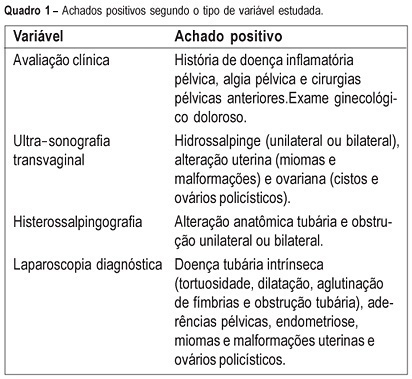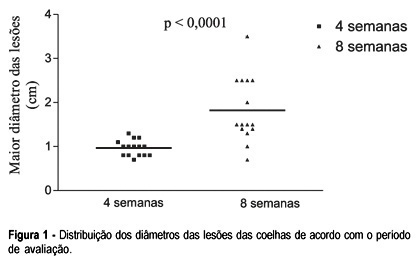You searched for:"Julio César Rosa e Silva"
We found (18) results for your search.Summary
Revista Brasileira de Ginecologia e Obstetrícia. 2005;27(7):401-406
DOI 10.1590/S0100-72032005000700006
PURPOSE: to evaluate the agreement between noninvasive methods - pelvic pain, transvaginal ultrasound and hysterosalpingography - and the gynecologic endoscopy approach for the diagnosis of tuboperitoneal factors responsible for conjugal infertility. METHODS: this is a cross-sectional study including 149 infertile patients who were submitted to clinical evaluation, transvaginal ultrasound, hysterosalpingography, hysteroscopy, and laparoscopy. In the evaluation of pelvic pain, the following complaints were considered to be abnormal: pelvic pain of the dyspareunia type, dysmenorrhea or acyclic pain, and pain upon mobilization of the cervix and palpation of the adnexa. Ultrasonographic examination was considered to be altered when adnexal or uterine morphological changes (hydrosalpinx, myomas or uterine malformations) were detected. Hysterosalpingography was considered to be abnormal in the presence of anatomical tubal changes and unilateral or bilateral obstruction. The agreement between noninvasive methods and endoscopy was evaluated by kappa statistics. RESULTS: the agreements between pelvic pain, transvaginal ultrasound, and hysterosalpingography and the endoscopic approach were 46.3% (kappa=0.092; CI 95%: -0.043 to 0.228), 24% (kappa=-0.052; CI 95%: -0.148 to 0.043), and 46% (kappa=0.092; CI 95%: -0.043 to 0.228), respectively. When at least one alteration detected by noninvasive methods was considered, the agreement with endoscopic approach was 63% (kappa=-0.014; CI 95%: -0.227 to 0.199). Sensitivity and specificity in predicting alterations on endoscopic approach were 39.5 and 80% in the presence of pelvic pain, 14.5 and 72% in the presence of alteration on transvaginal ultrasound, 39.5 and 80% in the presence of alteration on hysterosalpingography, and 70.2 and 28% in the presence of at least one alteration by noninvasive methods. CONCLUSION: there is a poor diagnostic agreement between the several noninvasive methods and endoscopy in the investigation of conjugal infertility secondary to tuboperitoneal factors.

Summary
Revista Brasileira de Ginecologia e Obstetrícia. 2009;31(9):425-426
Summary
Revista Brasileira de Ginecologia e Obstetrícia. 2016;38(1):47-52
Patient autonomy has great importance for a valid informed consent in clinical practice. Our objectives were to quantify thedomains of patient autonomy and to evaluate the variables that can affect patient autonomy in women with chronic pelvic pain.
This study is a cross sectional survey performed in a tertiary care University Hospital. Fifty-two consecutive women scheduled for laparoscopic management of chronic pelvic were included. Three major components of autonomy (competence, information or freedom) were evaluated using a Likert scale with 24 validated affirmatives.
Competence scores (0.85 vs 0.92; p = 0.006) and information scores (0.90 vs 0.93; p = 0.02) were low for women with less than eight years of school attendance. Information scores were low in the presence of anxiety (0.91 vs 0.93; p = 0.05) or depression (0.90 vs 0.93; p = 0.01).
Our data show that systematic evaluation of patient autonomy can provide clinical relevant information in gynecology. Low educational level, anxiety and depression might reduce the patient autonomy in women with chronic pelvic pain.
Summary
Revista Brasileira de Ginecologia e Obstetrícia. 2004;26(6):495-495
Summary
Revista Brasileira de Ginecologia e Obstetrícia. 2016;38(2):53-55
Summary
Revista Brasileira de Ginecologia e Obstetrícia. 2006;28(10):612-623
DOI 10.1590/S0100-72032006001000008
Despite a wide heterogeneity of clinical manifestations related to endometriosis, a high prevalence of the disease is observed in infertile women and in those with chronic pelvic pain. This enigmatic condition has a high socioeconomic impact, and the described data regarding efficacy of the therapeutic approaches are quite conflicting. Thus, the purpose of the present study was to describe the available scientific evidence about the applicable therapeutic modalities and to provide recommendations for the treatment of infertility and the chronic pelvic pain related to endometriosis. Although suppression of ovarian function in patients with minimal or mild endometriosis is not effective in improving fertility, ablation of the lesions associated with adhesiolysis seems to be more effective than exclusive diagnostic laparoscopy. There is no sufficient evidence to determine whether surgical excision in cases of moderate or severe disease would improve the pregnancy rates. In vitro fertilization seems to be an adequate approach, especially in cases of coexistence of infertility factors and/or failure of other treatments. The possibility of using GnRH for 3 to 6 months before in vitro fertilization should be considered. Regarding pain relief, suppression of ovarian function for 3 to 6 months in patients with laparoscopically-confirmed disease reduces the pain associated with endometriosis. All studied medication seem to have similar efficacy, differing only in terms of adverse effects and costs. Ablation of endometriotic lesion reduces the pain associated with endometriosis, being less effective in cases of minimal disease. Exeresis of endometriomas with diameter > 4 cm seems to improve the rate of natural fecundity and the rate for ??? obtained after assisted reproduction procedures, in addition to reducing both pain and recurrence risk. Finally, it is important to emphasize that this subject is much controversial and the recommendations herein described should be revised as randomized controlled clinical trials with adequate casuistic generate more concrete and reliable evidence.
Summary
Revista Brasileira de Ginecologia e Obstetrícia. 2023;45(11):635-637
Summary
Revista Brasileira de Ginecologia e Obstetrícia. 2004;26(9):715-719
DOI 10.1590/S0100-72032004000900007
PURPOSE: development of a new experimental model of endometriosis induction in rabbits evaluating its temporal evolution both macro-and microscopically. METHODS: thirty female rabbits were submitted to endometriosis induction through the fixation of a piece of the left uterine horn to the abdominal peritoneum. After four or eight weeks the viability of the lesions was verified by laparoscopy. The lesions were observed endoscopically. The implants were measured and histological analyses were made. The groups were compared for the presence of endometriotic lesion on laparoscopy, presence of adhesions, implant size and histological aspects. For statistical analyses we utilized Student's t and Mann-Whitney's tests, with a statistical significance of 5%. RESULTS: endometriotic lesions were identified in all cases submitted to laparoscopy after 4 weeks of induction, 64% of them cystic, and in 80% of the rabbits after eight weeks, 66% of which cystic. The adhesions were present in 71% of the rabbits after 4 weeks (none in the implants) and in 80% of the rabbits after 8 weeks (13% in the implants). The lesions were significantly larger after 8 weeks (p<0,0001). The histological analyses showed 100% of endometrial tissue in both groups. CONCLUSION: this experimental model showed that it is possible to simulate endometriosis in rabbits with a viable and simple technique, also allowing to record the characteristics and development of the implants macro-and microscopically. Although the histological aspects were similar, the lesions after eight weeks were larger than after four, making their manipulation easier.
